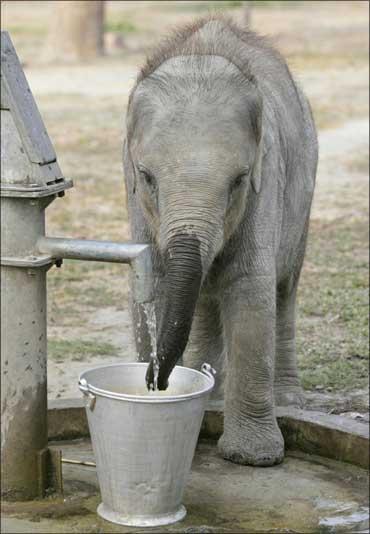
Demand for water is growing in most cities across India as every urban citizen now requires almost double the amount of water s/he needed five years back.
With urban India growing by leaps and bounds, it is expected to experience a severe water crisis by 2020 and the per capita availability of water is projected to be less than 1,000 cubic metres.
By the year 2020, says a World Bank report, most major Indian cities will run dry. India's supply of water too is rapidly dwindling primarily due to mismanagement of water resources, although over-pumping and pollution are also significant contributors.
The shortage of water points to a grim situation as it is bound to adversely affect economic and agricultural growth too.
Not long ago, most of our cities were self-sufficient in meeting their water needs from the extensive urban water bodies.
Today, these water bodies have disappeared. Municipalities have been stretched to their limits to find water for the growing populations. Groundwater is being mindlessly extracted by the government as well as by private parties.
These are the reasons that make rainwater harvesting indispensable for a country like ours. With industrialisation being the need of the hour, we just cannot afford to ignore it.
In fact, many environmental groups in India are demanding that water harvesting should be made mandatory for all new buildings and housing societies in the urban areas across the country.
To get an idea of water harvesting and its utilities in modern India, read on.
. . .
Sources: UNEP; rainwaterharvesting.net; rainwaterharvesting.org
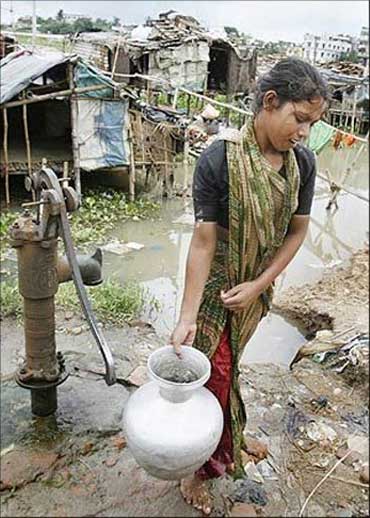
What is rainwater harvesting?
Rainwater harvesting is the collection and storage of rainwater. Rainwater can be harvested either in containers above or below ground. Rainwater can also be charged into the soil for withdrawal later: this method is termed 'groundwater recharging'.
Its history in Asia can be traced back to the 9th or the 10th century which saw small-scale collection of rainwater from roofs and simple brush dam constructions in the rural areas of south and southeast Asia.
Rainwater collection from the eaves of roofs or via simple gutters into traditional jars and pots has been traced back almost 2 000 years in Thailand (Prempridi and Chatuthasry, 1982).
Rainwater harvesting was a common phenomenon in the Loess Plateau regions of China years ago.
More recently, however, about 40,000 well storage tanks, in a variety of different forms, were constructed between 1970 and 1974 using a technology which stores rainwater and stormwater runoff in ponds of various sizes. A thin layer of red clay is generally laid on the bottom of the ponds to minimise seepage.
In most cases, trees, planted at the edges of the ponds, help to minimise evaporative losses from the ponds.
. . .
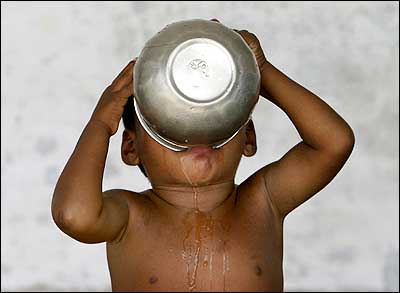
Following are the areas from where water can be harvested:
Rooftops: If buildings with impervious roofs are already in place, the catchment area is effectively available free of charge and they provide a supply at the point of consumption.
Paved and unpaved areas i.e., landscapes, open fields, parks, stormwater drains, roads and pavements and other open areas can be effectively used to harvest the runoff. The main advantage in using ground as collecting surface is that water can be collected from a larger area. This is particularly advantageous in areas of low rainfall.
Waterbodies: The potential of lakes, tanks and ponds to store rainwater is immense. The harvested rainwater can not only be used to meet water requirements of the city, it also recharges groundwater aquifers.
Stormwater drains: Most of the residential colonies have proper network of stormwater drains. If maintained neatly, these offer a simple and cost effective means for harvesting rainwater.
The decision whether to store or recharge water depends on the rainfall pattern and the potential to do so, in a particular region. The sub-surface geology also plays an important role in making this decision.
. . .
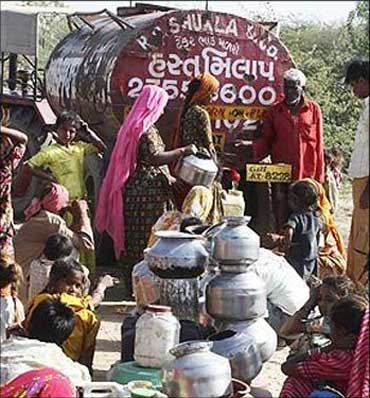
Rainwater harvesting system has five components. These are: catchment, conveyance, filtration, storage and recharge.
Catchment
Roofs and paved areas which are clean are excellent catchment. Unpaved areas are usually best reserved to ensure increase in soil moisture or to recharge groundwater.
Even factory roofs are good for the purpose as long as they are kept clean.
The use of bitumen and asphalt as water proofing in some of the old factories may render the catchment unfit. Chimneys which deposit soot may need to be isolated.
Conveyance
This includes gutters and pipes which move the rainwater from the catchment to the filtration system. Polyvinyl chloride or PVC is the material generally used for both gutters and down pipes.
Filtration
Filtration systems remove organic material, silt and other debris from rooftop rainwater. These are designed with gravel and sand and sometimes with nylon meshes. Rainwater passes through the filter and is cleaned for storage.
Storage
There are many ways to store rainwater. Rain barrels are one of the methods in which tanks are used to collect and store rainwater. Underground open or closed sumps are preferred by some.
Recharge
Rainwater may also be used for groundwater recharge, where the runoff on the ground is collected and allowed to be absorbed, adding to the groundwater. In the US, rooftop rainwater is collected and stored in sump. In India, this includes bawdis (wells) or ponds which collect the run-off from small streams in wide area.
. . .
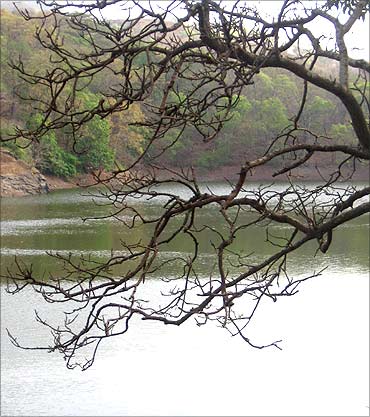
What is the utility of water harvesting?
Rainwater harvesting is most suitable where:
Practical advantages of rainwater harvesting are as follow:
Its qualitative advantages are:
. . .
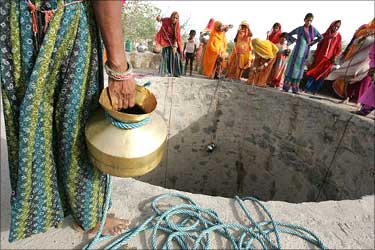
Water harvesting: Some FAQs
Can we harvest rain at our homes?
Yes we can. Structures to harvest rain require little space.
A dried borewell, a row of soak pits or a tank--concealed below the ground -- are all that we need. The open spaces -- rooftops and ground -- can be used as your catchment (surface to catch rain).
How much does it cost?
Rainwater harvesting methods are site specific and hence it is difficult to give a generalised cost.
But it should be remembered that the major components of a rainwater harvesting system -- rain and catchment area -- are available free of cost.
A good proportion of the expenses would be for the pipe connections.
By judiciously fixing up the slopes of roofs and location of rainwater outlets, this could be brought down.
Typically, installing a water harvesting system in a building would cost between Rs 2,000 to 30,000 for a building of about 300 sq m.
Given below is a rough estimate:
a. Unit cost of construction activities.
Excavation in soils cu. m. 90 Excavation in rock cu. m. 150 Brickwork with cement mortar (1:6) cu. m. 1400 Plain cement concrete (1:3:6) cu. m. 1500 Reinforced cement concrete (1:2:4) cu. m. 4700.00Including steel bars, shuttering etc. cu. m. 4700 PVC piping for rainwater pipes
- 110 mm diameter
- 200 mm diameter
Metre
metre
165
275 Making borehole in metre 165.00Soft soil (with 150 mm diameter PVC casing) metre 180
b. Ferrocement tanks with skeletal cage
7,000 9,000 10,000 Total cost in rupees 12,430 12,975 13,970 14,380 15,800
Source: Action for food Production and United Nations Children's Fund, Rooftop rainwater harvesting systems
How long does the entire process take?
We need someone who understands rainwater harvesting. It is simple but it still needs someone who has experience in the principles of rainwater harvesting. Then a skilled mason or a plumber can do the job for you within 10 days.
Who will be the beneficiaries?
We all will benefit tremendously from water harvesting. Our groundwater will be recharged because of this method. But as groundwater moves, our neighbours will gain too.
Therefore, for best results, we should get our neighbours to become rainwater harvesters as well.
What will be the quality of water?
Since we are putting rain water into the ground, which once contaminated, cannot be cleaned easily. We should not let water with sewage or other dirt flow into your recharge pits.
This is why the cleanest rainwater is from our rooftops. There are also filters to keep some dirt out.
Does it require a lot of maintenance?
The entire set-up needs maintenance once or twice a year, at very little cost.
Rainwater harvesting means that w have to get involved. This is about making water our business.
This is about building our relationship with water and with the environment. Through this process, we learn the value of each raindrop.
Information courtesy: https://www.rainwaterharvesting.org/
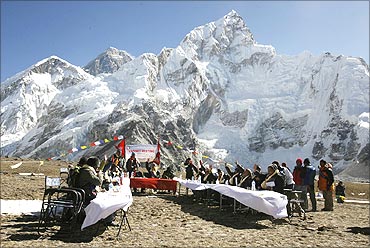
Rainwater harvesting: Its significance across the world
Global freshwater reserves are rapidly depleting and this is expected to significantly impact the most populated areas of the world.
Low to middle income developing regions as well as highly developed countries will face water stress in the future, unless existing water reserves are managed effectively.
Although low and middle income developing countries currently have low per capita water consumption, rapid growth in population and inefficient use of water across sectors is expected to lead to a water shortage in the future
Developed countries traditionally have high per capita water consumption and need to focus on reducing their consumption through improved water management techniques and practices.
Climate change is expected to worsen the situation by causing erratic and unpredictable weather, which could drastically diminish the supply of water coming from rainfall and glaciers.
By 2025, India, China and select countries in Europe and Africa will face water scarcity if adequate and sustainable water management initiatives are not implemented, and an estimated 3 billion people will be living below the water stress threshold, says a study by Grail Research.
Water.org, a non-government organisation with which Hollywood actor Matt Damon is closely attached with, gives some terrifying water facts (globally):
. . .
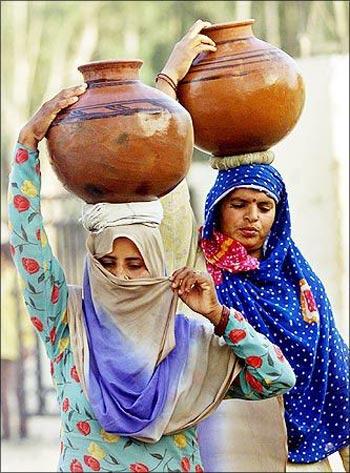
Where does India stand
By the year 2020, says a recent World Bank report, most major Indian cities will run dry. Given the state of the monsoon this year, it would appear that the World Bank report has come true almost a decade earlier.
Severe water shortage had already led to a growing number of conflicts across the country, with 90 per cent of India's territory served by inter-state rivers.
India's supply of water too is rapidly dwindling primarily because of mismanagement of water resources, although over-pumping and pollution are also significant contributors.
Climate change is expected to worsen the situation by causing erratic and unpredictable weather, which could drastically diminish the supply of water coming from rainfall and glaciers.
However, we are not still ready to accept the reality of depleting groundwater reserves in India. This condition has caused a major water crisis.
According to the Ministry of Water Resources, industrial water use in India stands at about 50 billion cubic meters or nearly 6 per cent of total freshwater abstraction.
Water availability, both in terms of quality and quantity, has declined to such an extent that many parts of India, rural and urban, today face a drought-like situation.
And when drought actually sets in, scarcity takes on a dangerous shape.
We need to take rational steps immediately to manage water in India before it becomes an international crisis.
Rays of hope: A recent Business Standard report, however, talked about a unique method of water preservation practised by people in Rajasthan.
The water preservation methods followed here are believed to have been developed by the Paliwal brahmins around 500 years ago. They were the first to notice the gypsum belt which lies below the surface of sand.
Gypsum is a non-porous element, which doesn't allow water to seep through. When raindrops fall on the surface of sand, its particles start behaving like sponge and absorb every drop of this water. Over a period of time, water gets deposited between the upper layer of sand and the lower layer of gypsum belt.
The gypsum belt, because of being non-porous, prevents it from reaching the level of the groundwater, thereby preventing it from getting saline.
Government initiatives
According to the chairman of the Indian Central Ground Water Board, the Indian government has taken various steps to get the groundwater problem under control, rainwater harvesting being one of them.
Other important steps include capacity building, an awareness campaign on water harvesting and conservation of water resources and regulation of groundwater development in selected areas.
Along with the central government, the state governments are also involved in the fight against the dropping water table.
They are offering stimuli to grow crops that require less water, they are placing restrictions on financial institutions providing loans for procurement of submersible pump rigs, and they are trying to stagger the sowing season in such a way as to reduce the peak water demand.